AFV Club 1/350 Type VIIb U-boat
|
KIT #: |
SE 73502 |
|
PRICE: |
$1600 yen at
www.hlj.com $21.50 US SRP |
|
DECALS: |
Three options |
|
REVIEWER: |
Tom Cleaver |
|
NOTES: |
|
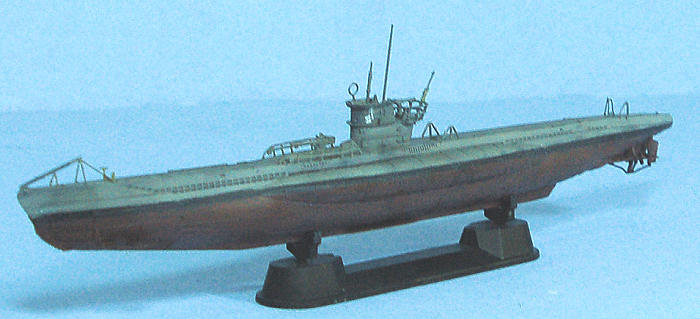
The Type
VII
U-boat first appeared as the VIIA in 1936. While it was not the best submarine
in any particular aspect, it was the most successful submarine of the Second
World War, forming the backbone of the U-boat force throughout the war.
The Type
VII
became the main craft of the U-boat force for two reasons. The first was
technical. The Type
VII
had the range, sea worthiness, armament, and maneuverability to conduct an
anti-shipping war in the
North Atlantic.
Additionally, the Type
VII
was relatively cheap and could be built quickly using mass-production
techniques. Secondarily, naval
policy influenced the selection.
Under the 1935 Anglo-German Naval Agreement,
Germany
was allowed to construct submarines up to 35 percent the tonnage of the Royal
Navy submarine fleet, which was later increased to 100 percent. The Type
VII,
as a medium-tonnage boat, could be built in greater numbers under these
restrictions.
709 Type
VII
U-boats of all variants were built during the war, more than any other submarine
type built by any other nation. 24
of these were the Type VIIB, which was the mount of several of the early war
U-boat “aces” like Gunther Prien and Otto Kretschmer.
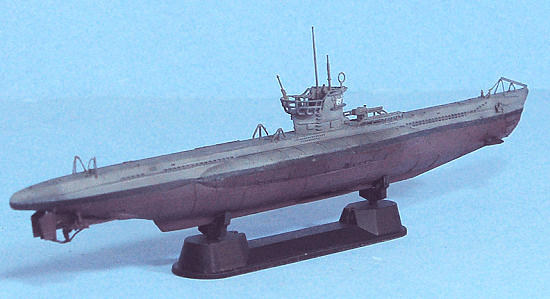 Gunther Prien and the Attack
on
Scapa Flow:
Gunther Prien and the Attack
on
Scapa Flow:
On October 13, 1939, Kapitaen-Leutnant Gunther Prien carried out
“Operation Order North Sea Number 16”, which was destined to be one of the most
audacious missions by any unit of either side during the Second World War.
The Royal Navy base at
Scapa Flow
in the
Orkney Islands
north of
Scotland
commanded the
North Sea,
which was the main naval battleground between
Britain
and
Germany
in both World Wars. The base had a
special pull on the leaders of the Kriegsmarine, because it was there on
June 21, 1919 that the German High Seas Fleet - consisting of 5 battle cruisers,
8 cruisers, 11 battleships and 50 destroyers - was scuttled rather than be
turned over to the Allies in the Treaty of Versailles.
Throughout the interwar years, German naval officers had worked and
planned to find a way to repay the British at the scene of their humiliation,
should another war break out.
The Royal Navy viewed
Scapa Flow
as being impregnable, particularly against submarine attacks; this was not only
because of the fortifications, but also because of the natural geography of the
base. A body of water surrounded by
islands,
Scapa Flow
had were seven entrances. The three
main entrances were protected by anti‑submarine booms which were opened to allow
ships to pass. The four other
channel entrances were narrow and shallow, with strong currents it was believed
would carry any U‑boat off‑course.
Additionally, the channels were subject to very high tides and low tides, with
currents fluctuating from relatively fast to raging strong.
During the First World War these channels were also blocked by wrecks
filled with concrete. Moored mines
and steel cables were also laid against any underwater penetration, while large
search lights were strategically placed around the narrow entrances. With the
international situation deteriorating in 11111938, the Royal Navy reactivated
the base. Among other additions to
the defenses, the scuttled German battlecruiser Derfflinger, was raised
and put to use as a block ship, which was taken by the Kriegsmarine as the
direct insult it was intended to be.
The British had good cause to believe these defenses were sufficient.
During the First World War the Germans had attempted U-boat attacks twice
- U‑18 in 1914 and UB‑116 in 1918 ‑ both being destroyed.
Any attack on the base was fraught with danger and required not only the
highest level of seamanship but also nerves of steel and luck, since any
approach had to be on the surface, at night, at high tide when the current was
weakest, under the cover of the Dark of the Moon. The best route was through
Holm Sound at the eastern end, through Kirk Sound, navigating through the sunken
blockships and thence into
Scapa Flow.
Kirk Sound was only 500 meters wide and 15 meters deep at its deepest, with the
deepest section path of the channel blocked by three blockships with a fourth to
the side, obstructing any straight
passage attempts. The gaps a U-boat might get through were a narrow 170 meters,
but most were impassible because they were too shallow.
The one place a U-boat could slip through required it to pass right next
to the fourth blockship with a depth of only seven meters deep.
Going off course would result either in a collision or being beached on
the shore.
Immediately upon the outbreak of war in September 1939, Admiral Donitz
ordered an attack be made, to force the British to abandon the base while it was
strengthened in the aftermath, which would put the Royal Navy at a geographic
disadvantage in the
North Sea.
The man assigned to carry out the mission was Kapitaen-Leutnant Gunther
Prien, age 31; The U-boat he commanded was U-47, a Type VIIB.
In the month of September 1939 alone, Prien had sunk three British
merchant ships with a total of 66,000 tons during his first war patrol and been
awarded the Iron Cross Second Class. William L. Shirer, an American journalist
who met him in Berlin described Prien as “clean‑cut, cocky, a fanatical Nazi and
obviously capable.”
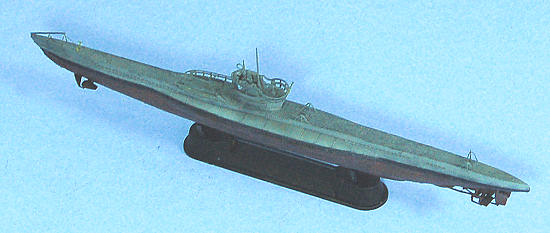 Donitz called in Prien on October 1, and he was briefed on the mission.
The penetration of Scapa Flow was to take place Friday night, October
13/14, which was a moonless night when the tide would be the highest for the
time of year. U-47 would depart
Kiel the preceding Sunday, October 8th.
Prien was to unload all sensitive equipment, including the Enigma
machine, secret papers, and all non‑essential provisions. The attack would be
made with explosives already rigged and ready to scuttle U-47 on moment’s
notice, to prevent capture. The steam-powered G7a torpedoes were unloaded and
replaced by the new wakeless, electrically powered G7e torpedo.
Donitz called in Prien on October 1, and he was briefed on the mission.
The penetration of Scapa Flow was to take place Friday night, October
13/14, which was a moonless night when the tide would be the highest for the
time of year. U-47 would depart
Kiel the preceding Sunday, October 8th.
Prien was to unload all sensitive equipment, including the Enigma
machine, secret papers, and all non‑essential provisions. The attack would be
made with explosives already rigged and ready to scuttle U-47 on moment’s
notice, to prevent capture. The steam-powered G7a torpedoes were unloaded and
replaced by the new wakeless, electrically powered G7e torpedo.
U-47 left Kiel on October 8 and spent the next four days in the North Sea
running submerged during the day and avoiding any ships sighted when surfaced at
night, to the puzzlement of the crew.
On the evening of October 12, Prien put U‑47 on the bottom of the North
Sea, 1.8 nautical miles from the British base, then gathered his 40-man and told
them of the mission.
At 1915 on October 13, 1939, U‑47 surfaced and commenced the approach.
The moon might not have been visible, the entire area was ablaze with the
shimmering glow of the Northern Lights.
After a moment’s hesitation, Prien ordered “All ahead standard.” For the
next four hours, U‑47 worked her way into Scapa Flow.
As they approached Holm Sound at 2307, a merchant ship was spotted and
U-47 submerged. The ship passed and
Prien surfaced at 2331. He headed
for Kirk Sound and the gap between the blockships. The distance between the
Thames and Soriano blockships was 55 feet.
Suddenly a fierce tide swept U‑47 forward, at what Prien later described
as an “unbelievable speed”. The
approach had not been perfect, and
Prien suddenly spotted wire cables running across the hulks, the anchoring lines
that held them in position. The current was too strong to turn back, so Prien
steered for the center of the gap in the hope that U-47 could ride over the
cables stretched beneath the surface.
As the keel struck the cables, the sound of scraping metal reverberated.
U-47 scraped over the cables, but the contact jostled the submarine to
the right, where it bumped the bottom and ran aground.
Maneuvering with a combination of rudder and engine was unsuccessful. If
they were still stuck at dawn, U‑47 would be scuttled. Prien had made his
approach with his ballast tanks partially flooded, to stay low and reduce the
silhouette. The tanks were blown
and U-47 finally floated free with Prien immediately turned hard port to get
back in the current.
The channel widened and the current slowed. U‑47 sailed into the darkness
of Scapa Flow. With the Northern
Lights, the crew could see shore activity.
Suddenly, the conning tower of the U‑boat was illuminated by the
headlights of a car. Were they
seen? The light faded as the car made a turn away from the shore.
At 0020 October 14, “Wir sind im Scapa Flow!” (“We are in Scapa Flow!”)
was recorded in the log.
Visibility was extremely good.
The bridge watch expected to
find the Home Fleet but there was nothing. U‑47 headed west for 3.5 miles
without sighting any ships. Prien
turned and headed back, almost reaching Kirk Sound, By now they had been in the
anchorage for 30 minutes and still had seen nothing. The British Home Fleet was
not home.
Unbeknownst to Prien, the Home Fleet had sortied into the North Sea on
October 9. On October 8, the day
U‑47 departed Kiel, the new battle cruiser Gneisenau and light cruiser
Koln had sortied into the North Sea, to lure the Royal Navy into range of
Luftwaffe aircraft. The British
Fleet, believing Gneisenau was headed for the North Atlantic, sortied to
intercept her. Gneisenau retreated, having lured the Home Fleet in range
of the Luftwaffe, which attacked the British fleet on October 9 with over
a hundred bombs – without a single hit.
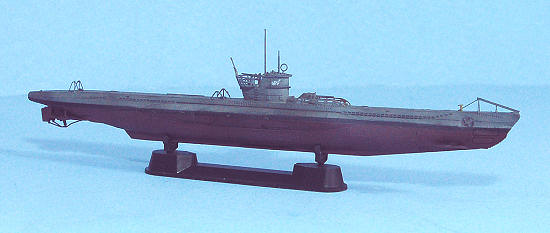 Unaware of Gneisenau’s return to Kiel, the British hunted north of
the Orkneys before they finally broke off the search. The battleships Nelson
and Rodney, battle cruisers Hood and Repulse and the
carrier Furious retired to Loch Ewe in western Scotland. The Gneisenau
sortie had emptied Scapa Flow of the major capital ships, leaving only the old
29,000 ton battleship Royal Oak, left out of the hunt since her top speed of 20
knots was too slow to keep up with the modern fleet. She was ordered to depart
Scapa Flow the morning of October 14, since the British believed a bomber attack
was coming.
Unaware of Gneisenau’s return to Kiel, the British hunted north of
the Orkneys before they finally broke off the search. The battleships Nelson
and Rodney, battle cruisers Hood and Repulse and the
carrier Furious retired to Loch Ewe in western Scotland. The Gneisenau
sortie had emptied Scapa Flow of the major capital ships, leaving only the old
29,000 ton battleship Royal Oak, left out of the hunt since her top speed of 20
knots was too slow to keep up with the modern fleet. She was ordered to depart
Scapa Flow the morning of October 14, since the British believed a bomber attack
was coming.
Growing desperate, Prien turned north to probe the northeast corner. He
finally saw the silhouette of a large ship, berthed unusually close to shore,
she was identified as the Royal Oak. A mile beyond was another ship. With
nothing more than the bow in sight, Prien mistook the old seaplane tender
Pegasus for the battle cruiser Repulse.
By 0055, U‑47 was in position, 3,500 yards from the Royal Oak.
The four bow tubes were made ready.
Two torpedoes were aimed at Royal Oak, with the other two at what
was still believed to be Repulse.
Only three torpedoes fired, with the fourth jamming in its tube.
After a three and a half minute run, one small explosion was heard. The
other two had misfired – a common flaw with early electric torpedoes. The one
hit blew a hole in the starboard bow, near the anchor chains.
Roused from their bunks, 1,200 men saw water gushing like a fountain onto
the forward deck. Captain William Benn was told the most likely cause was an
internal explosion; a rumor spread that a refrigerator had blown up. Others
believed a high flying German bomber had dropped a bomb. No one considered a
U‑boat attack. No special precautions seemed necessary or were taken; the men
returned to their bunks.
U‑47 prepared to strike again. Prien thought that one torpedo had struck
the Repulse and the other two had missed the Royal Oak. He attributed the miss
to faulty torpedoes. While the bow tubes were being reloaded, Prien swung U-47
around and fired the stern torpedo at Royal Oak. It missed! Prien was
determined to finish the job.
At 0125, tubes 1, 2 and 4 were ready.
Prien edged into point blank range and fired all three at Royal Oak,
which he thought was unharmed. All three hit within ten seconds of each other.
The blasts set off a series of raging fires that ignited the cordite magazine,
which exploded with a fiery orange blast right through the main deck.
Royal Oak listed 45 degrees to starboard. Her great 15 inch shells
came off their racks in the magazine room and exploded. Water gushed in below
decks, uncontrollable fires raged on the upper decks. 13 minutes later, she
rolled over and sank, taking 833 sailors and officers of her 1,200‑man crew –
among them Rear Admiral Henry Evelyn Blagrove, the commander of the 2nd Battle
Squadron.
At 0128, believing he’d been seen Prien headed towards the Kirk Sound
exit at high speed. U-47 still had five serviceable torpedoes but would need 30
minutes to reload them. After a
short run, U-47 reached Kirk Sound; Prien took
the southern path, through the blockship Minich and the coast of
Lamb Holm. Despite strong 10-knot currents now running through the channel,
Prien passed the southern blockship “with nothing to spare.” Clear of the
blockships, Prien ordered flank speed towards Holm Sound. At 0215, he logged,
“we are once more outside”
 The British were still convinced Royal Oak had sunk from an internal
explosion. At dawn, divers went
down to the wreck and identified three holes blown by torpedoes when they
discovered the propeller of one torpedo.
The truth was dismaying: a U-boat had penetrated the Royal Navy’s most
important base! Destroyers searched
the Flow for a week, but Prien was long gone.
The
BBC
announced the sinking of Royal Oak on October 14, stating that the U-boat had
also been sunk. Donitz had no idea
whether Prien had escaped until he made radio contact on October 16.
The British were still convinced Royal Oak had sunk from an internal
explosion. At dawn, divers went
down to the wreck and identified three holes blown by torpedoes when they
discovered the propeller of one torpedo.
The truth was dismaying: a U-boat had penetrated the Royal Navy’s most
important base! Destroyers searched
the Flow for a week, but Prien was long gone.
The
BBC
announced the sinking of Royal Oak on October 14, stating that the U-boat had
also been sunk. Donitz had no idea
whether Prien had escaped until he made radio contact on October 16.
U‑47 sailed into Kiel on October 17, cheered by the crew of Scharnhorst.
They were met at the dock by Admirals Donitz and Raeder, who awarded
Prien the Iron Cross First Class and the Iron Cross Second Class to all other
crewmen. Hitler was anxious to meet the new hero and that afternoon the entire
crew was flown to Berlin in Hitler’s personal airplane.
There they were paraded in a motorcade through Berlin. It was the
greatest, most grandiose celebration of a naval battle victory in Germany.
Prien was awarded the Knight’s Cross of the Iron Cross by Hitler
personally.
The victory at Scapa Flow was primarily one of propaganda. Royal Oak was
too old and too slow for active service, and her loss did not materially affect
the Royal Navy. The attack ended
several careers; First Lord of the Admiralty Winston Churchill escaped only
because he was just recently appointed.
The Flow’s defenses were further increased, with additional blockships
sunk, completely sealing off the channel. Until Scapa Flow could be made secure,
the Home Fleet dispersed to other anchorages. Donitz had already mined the most
likely refuges, and these damaged Nelson and the cruiser Belfast,
while four other vessels were sunk.
Winston Churchill called the mission ”a remarkable exploit of
professional skill and daring”.
AFV
Club’s 1/350 Type VIIB follows their earlier VIIC, and joins the Revell
1/350 Type VIIC and Hobby Boss 1/350 Type XIB to bring the grey wolves of
the Kriegsmarine to this scale.
The
AFV
Club kit is extremely petite, with fewer than 35 parts, but many of these
parts, like the railings, are so well done in such small detail that they
are superior to the photoetch parts that are provided.
Decals allow the modeler to make U-47 with her “Bull of Scapa Flow”
insignia, as well as the most successful U-boat of all, Otto Kretschmer’s
U-99. (Interestingly, both
Prien and Kretschmer were lost in the same convoy battle in 1941, with Prien
going down with his ship and Kretschmer surviving to become a POW.)
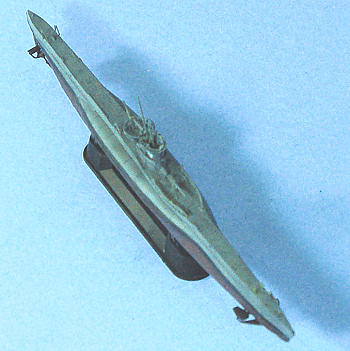 When one builds something that is only about 5 inches long, with lots of
really small detail parts that are - in 1/350 scale - really really small detail
parts, it’s a good idea to have a nice swing-arm magnifier lamp available.
I did almost all the work on this tiny model under the light and with the
visual aid of that lamp.
When one builds something that is only about 5 inches long, with lots of
really small detail parts that are - in 1/350 scale - really really small detail
parts, it’s a good idea to have a nice swing-arm magnifier lamp available.
I did almost all the work on this tiny model under the light and with the
visual aid of that lamp.
I have done the Revell 1/350 Type VIIC and, while it is a scale-down of
the very nice 1/144 kit, it is not nearly so petite and finely detailed as the
AFV
Club kit. The nice thing is that,
as is true with most submarine models, it is easy to assemble even in this
scale, due to the relative paucity of parts compared to any other ship model.
The instructions are clear and concise.
I first assembled the hull, then attached the diving planes, the screws
and the rudders. This hull is more
fiddly than the Revell kit, but the result has better detail to my mind.
I then assembled the conning tower, with the plastic railing, at glued it
to the hull. I left all the small
deck parts off until after the model was painted.
I first painted the entire model flat black.
When this was dry, I masked off the demarcation line, then painted the
lower hull Tamiya “Hull Red.” U-47
was one of the few U-boats that was not painted overall black below the water
line. When that was dry, it was
masked off and the upper hull and conning tower, and all the small parts, were
painted with Gunze H-317 Gray FS36231.
(Burbank House of Hobbies now being the only hobby shop on the west coast
that imports Gunze directly!) I
then applied a bit of Gunze Light Gull Gray and went back over the upper hull to
make the paint look worn. After I unmasked everything, I gave the upper hull a
light coat of Tamiya “smoke” to “pop out” the very nice surface detail.
I attached the various parts.
I managed to break the serrated mine-cutter for the bow, and ended up
scratchbuilding a replacement with some trimming from the frames of a photoetch
set, which could be cut to fit what was needed.
I managed to lose the photoetch railings, so ended up using the plastic
railings, which are among the most delicate plastic moldings I have ever seen,
and which look great on the finished model.
I applied the “Bull of Scapa Flow” decal to the conning tower.
When all had set up, I gave the model an overall coat of Xtracrylix Flat
Varnish.
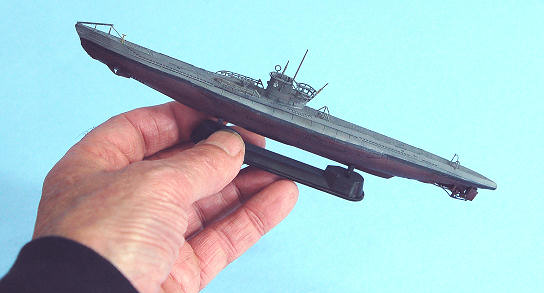 Wow! U-boats were really
small! Being able to put this model
near other ships made in the same scale, one is amazed to discover how really
small this most important weapons system of the Second World War - the German
weapon that came closest to winning the war for Hitler - really was.
You don’t get this with the larger scales, since there is nothing really
big to compare the model with. I
think I may put some photoetch figures on the conning tower deck, so others who
see this can get an idea of just how small these ships were, and how brave a man
had to be to go to war in them.
Wow! U-boats were really
small! Being able to put this model
near other ships made in the same scale, one is amazed to discover how really
small this most important weapons system of the Second World War - the German
weapon that came closest to winning the war for Hitler - really was.
You don’t get this with the larger scales, since there is nothing really
big to compare the model with. I
think I may put some photoetch figures on the conning tower deck, so others who
see this can get an idea of just how small these ships were, and how brave a man
had to be to go to war in them.
Review kit
courtesy of HobbyLink Japan. Get
yours at www.hlj.com
Tom Cleaver
November 2009
If you would like your product reviewed fairly and quickly, please
contact
me or see other details in the
Note to
Contributors.
Back to the Main Page
Back to the Review
Index Page


 Gunther Prien and the Attack
on
Gunther Prien and the Attack
on 


 When one builds something that is only about 5 inches long, with lots of
really small detail parts that are - in 1/350 scale - really really small detail
parts, it’s a good idea to have a nice swing-arm magnifier lamp available.
I did almost all the work on this tiny model under the light and with the
visual aid of that lamp.
When one builds something that is only about 5 inches long, with lots of
really small detail parts that are - in 1/350 scale - really really small detail
parts, it’s a good idea to have a nice swing-arm magnifier lamp available.
I did almost all the work on this tiny model under the light and with the
visual aid of that lamp.